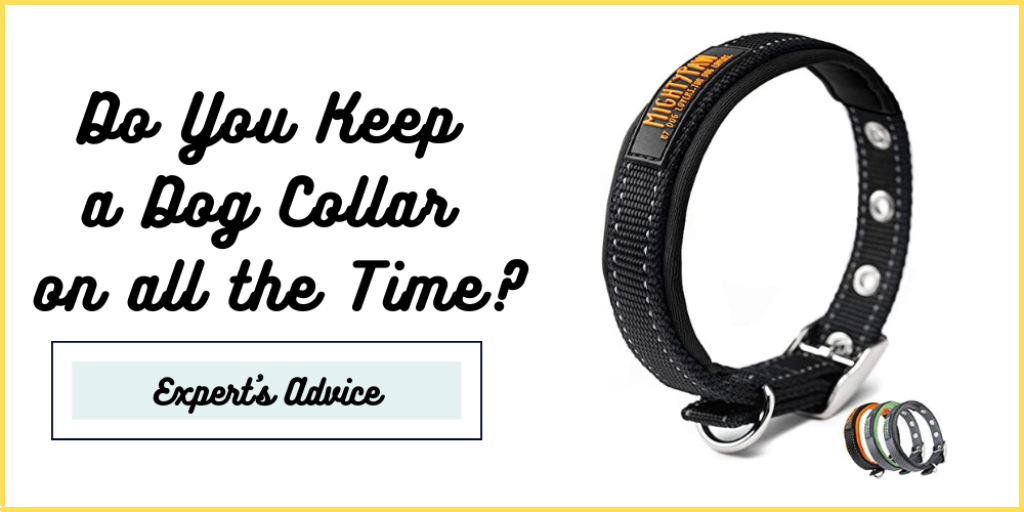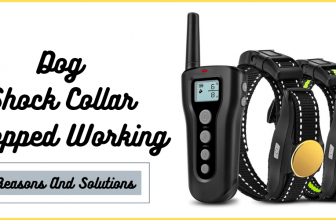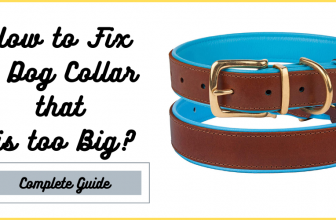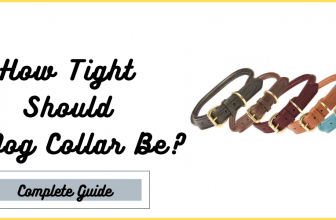The collar is an essential accessory for any dog. However, the collar should not be always used on a dog. There are some important guidelines to properly use this accessory and avoid discomfort or health problems in dogs. Here you can learn everything you need to know to use the collar on dogs properly.
Nowadays, we can not find a unanimous opinion regarding the use of the collar in dogs. However, some guidelines can be taken into consideration when there is prolonged use of the collar. The probability of a dog suffering any problem in the use of the collar increase if the use is prolonged.
Contents
Do You Keep a Dog Collar on all the Time? – Explained
Of course, dogs must wear collars at certain times in their lives. One of the classic problems with many dogs that walk down the street without a leash is that they tend to fight with other dogs. So, collars together with leashes are a set of accessories that allow controlling the behavior of dogs when it is necessary.
All this means that it is not recommended that dogs wear a collar all the time. Some problems can start to arise when dogs wear a collar too long. One of these problems is skin irritation or hair loss in the neck area. This is due to the constant rubbing it should cause with the dogs’ hair and skin.
The constant rubbing of the collar can be mild or intense depending on some factors. Some materials such as cheap nylon cause more intense and damaging rubbing than other materials such as leather. Even worse irritation and hair loss in dogs can be noticed with prolonged use of all-metal collars.
This means that dogs that wear a collar all the time are more likely to suffer from one or more problems or discomfort. Therefore, it is recommended that dogs use the collar when it is truly useful, such as in walking or training situations.
Should Dogs Sleep with Collars On?
One of the peculiarities of dogs is that not all of them sleep in the same position. At the same time, there are many doubts from owners about whether dogs should sleep with collars on. Here again, the same inconvenient situation occurs as mentioned above. The rubbing of the collar against the dogs’ skin and hair continues to occur.
That is why any dog may feel a little uncomfortable if it has to sleep with the collar on during the night or at any time of the day. There are also other problems besides hair loss or skin irritation in the neck area. Many dogs do not get a good night’s rest due to the discomfort of wearing the collar while sleeping.
This discomfort while sleeping can produce negative changes in the daily behavior of any dog. So, the most advisable thing to do in these cases is to prevent dogs from using their collar while sleeping. Dogs will enjoy a much more pleasant rest and other potential problems, such as hair loss and skin irritation.
How Often Should You Take Your Dog’s Collar Off?
The use of a collar on dogs must be considered along with a variety of other factors. Some dogs can live inside a home that is sufficiently sheltered. This means that these dogs cannot escape. So, when dogs are in the home, you should remove your dog’s collar.
Collars are also often used to add an identification tag with the dog owner’s details. That is why it is also important to use a collar on dogs when walking. Thus, you should not remove your dog’s collar if you have added an identification tag on the collar itself.
When dogs wear the collar in the home itself, this can also mean that they live in the yard or park of the house. Many people choose to collar their dogs in such situations.
Therefore, it is advisable to remove the collar from your dog at night. This guarantees many hours of sleep and allows the skin and hair in the neck area to be free of any friction.
Also Read: Can You Put Underground Dog Fence In Conduit?
Should You Take the Dog Collar Off at Night?
One of the most recommended habits when it comes to the use of a collar on a dog is also during the night. Beyond the habits of each dog, not all pets tend to sleep during the night. In any case, most people sleep through the night regardless of whether they have dogs or not.
It may indeed be necessary to remove a dog’s collar during the night. Many experts recommend putting the collar back on in the morning and taking it off at night before sleeping. Here again, it will be possible to avoid a wide variety of problems. Some of them are the ones we have mentioned, such as hair loss or skin irritation.
Additionally, there are other inconveniences to be taken into consideration. Many dogs tend to snag their collars during the night while their owners are sleeping. This situation can be somewhat dangerous for the dogs themselves. The dogs may be too uncomfortable to stay still if their collar has become entangled.
When this happens, any dog will want to escape by tugging. This can only lead to choking or hanging in the dogs themselves. So, to avoid this situation, it is advisable to avoid using collars on dogs at night.
Should a Dog Wear a Collar at Home?
Many people see the need for their dogs to wear a collar even though they are indoors. As we have mentioned above, one of the most recommended habits is to remove a dog’s collar if it is inside your home. In these cases, collars are only used on dogs during walks.
In any case, not all dogs are equally accustomed to wearing a collar when it is time to go for a walk. Some dogs need prolonged use of the collar if they have a stubborn personality. However, dog owners should consider really limited use of collars when the dogs are at home.
Another factor should also be considered in terms of the design of each home. Some homes do not have a fence high enough to prevent dogs from escaping into the street. So, to prevent dogs from getting lost in these situations, dogs should wear collars with identification tags. This allows dogs to be found more easily.
Should Puppies Wear Collars?
The use of collars on adult dogs is not the same situation as the use of collars on puppies. Here again, a wide variety of factors must be taken into consideration before deciding on the prolonged use of collars on puppies. Again, the most common criterion is to use a collar on a puppy only when it is time to walk.
This can avoid a high level of discomfort, as puppies may become upset with the use of a collar. However, it should also be considered that puppies that have not received the appropriate vaccinations or treatments are not usually walked at all. This is because here the puppies do not yet have the necessary protection from the dangers outside the home.
So, if this is the situation, it is not recommended that puppies wear collars. When puppies are close to the possibility of going for a walk, the use of a collar can be applied. This means applying the collar on the puppies for a few minutes or a few hours per day. In this way, the puppies can gradually become accustomed to the use of the collar.
Should You Leave a Collar on a Puppy?
The use of a collar on a puppy is necessary when they are already enabled to walk or socialize with other dogs. Here the collar is important since it allows the addition of an identification tag and the use of a leash for walking. In any case, the collar to be used on puppies should have the most appropriate size.
A collar that is too large can be enough to snag a puppy on an object. This is a dangerous situation for the puppy, as the risk of suffocation is high. Using a collar on puppies indoors is truly unnecessary. It does not require a high fence to prevent a puppy from escaping from the home.
Beyond the fact that puppies are too wiggly and playful, most of them are not tall enough to escape. So, leaving a collar on a puppy can only awaken potential dangers. Some puppies may have more sensitive skin than others. However, all of them will at some point suffer from skin irritation or hair loss with constant use of the collar.
Conclusion:
Incorporating a collar for dogs and puppies is always necessary. Yet, it is necessary to use a collar properly depending on the characteristics of the household or of each dog.
Excessive use of the collar in any dog can produce some problems and discomfort, such as skin irritation, hair loss, or hanging in the worst case.








